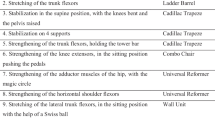Abstract
The aim of this study was to evaluate clinical and urodynamic observations on women with fibromyalgia (FM) and lower urinary tract symptoms (LUTS). Fifty-one patients with FM and LUTS and 50 patients with LUTS without FM answered questions about urinary symptoms and also two questionnaires about quality of life measures: “Medical Outcomes Study 36-Item Short-Form Health Survey” and “King's Health Questionnaire”. The urodynamic parameters evaluated were the following: maximum cystometric capacity, urine loss due to cough, Valsalva leak point pressure, and detrusor overactivity (DO). The groups were homogeneous concerning age, parity, body mass index, and genital prolapse. Symptoms such as increase of urinary frequency (p = 0.007) and urge urinary incontinence (p = 0.004) were statistically more common in the FM group. DO was the statistically most common urodynamic observation in patients with FM (p = 0.02). Regarding the questionnaires about quality of life, the patients with fibromyalgia and LUTS had the worst results in all fields. In conclusion, patients with FM and LUTS have detrusor overactivity more often as well as an increase of urinary frequency, contributing to the quality of life worsening.
Similar content being viewed by others
Abbreviations
- FM:
-
fibromyalgia
- LUTS:
-
lower urinary tract symptoms
- DO:
-
detrusor overactivity
References
Pongratz DE, Sievers M (2000) Fibromyalgia—symptom or diagnosis: a definition of the position. Scand J Rheumatol 29:3–7
White KP, Harth M (2001) Classification, epidemiology, and natural history of fibromyalgia. Curr Pain Headache Rep 5:320–329
Ang D, Wilke W (1999) Diagnosis, etiology and therapy of fibromyalgia. Comp Ther 25:221–227
Littlejohn GO (2004) Balanced treatments for fibromyalgia. Arthritis Rheum 9:2725–2729
Yunnus M, Masi AT, Calabro J et al (1981) Primary fibromyalgia (fibrositis): clinical study of 50 patients with matched normal controls. Semin Arthritis Rheum 26:817–824
Eich W, Hartmann M, Müller A, Fischer H (2000) The role of psychosocial factors in fibromyalgia syndrome. Scand J Rheumatol 29:30–31
Fietta P (2004) Fibromyalgia: state of the art. Minerva Med 95:35–52
Elam M, Johansson G, Wallin BG (1992) Do patient with primary fibromyalgia have an altered muscle sympathetic nerve activity? Pain 48:371–375
Vaeroy H, Helle R, Foore O, Kass E, Terenius L (1988) Elevated CSF levels of substance P and high incidence of Raynaud phenomenon in patients with fibromyalgia: new features for diagnosis. Pain 32:21–26
Ng SC (1992) The fibromyalgia syndrome. Singapore Med J 33:294–295
Clauw DJ (1995) Fibromyalgia: more than just musculoskeletal disease. Am Fam Physician 52:843–851
Clauw DJ, Schmidt M, Radulovic D, Singer A, Katz P, Bresette J (1997) The relationship between fibromyalgia and interstitial cystitis. J Psychiatr Res 31:125–131
Wallace DJ (1990) Genitourinary manifestations of fibrositis: an increased association with the female urethral syndrome. J Rheumatol 17:238–239
Stormorken H, Brosstad F (2005) Hypping vannlating-viktig diagnostisk markor ved fibromyalgi. Tidsskr Nor Laegeforen 125:17–19
Wolfe F, Smythe HA, Yunus MB, Bennet RM, Bombardier C, Goldenberg DL et al (1990) The American College of Rheumatology 1990 criteria for the classification of fibromyalgia: report of the multicenter criteria committee. Arthritis Rheum 33:160–172
Abrams P, Cardozo L, Fall M et al (2002) The standardization of terminology of lower urinary tract function: report from the Standardization Sub-committee of the International Continence Society. Am J Obstet Gynecol 187:116–126
Ware JE, Sherbourne CD (1992) The MOS 36-Item Short-Form Health Survey (SF-36): conceptual framework and item selection. Med Care 30:473–483
Kelleher CJ, Cardozo LD, Khullar V, Salvatore S (1997) A new questionnaire to assess the quality of life of urinary incontinent women. Br J Obstet Gynaecol 104:1374–1379
Tamanini JTN, Dáncona CAL, Botega NJ, Netto NR Jr (2003) Validation of the Portuguese version of the King's Health Questionnaire for urinary incontinent women. Rev Saúde Pública 37:203–211
Heesakkers JPFA, Vriesema LJ (2005) The role of urodynamics in the treatment of lower urinary tract symptoms in women. Current Opin in Urol 15:215–221
Sekido N, Hinotsu S, Kawai K, Shimazui T, Akaza H (2006) How many uncomplicated male and female overactive bladder patients reveal detrusor overactivity during urodynamic study? Int J Urol 13:1276–1279
Robertson AS, Griffiths CJ, Ramsden PD et al (1994) Bladder function in healthy volunteers: ambulatory monitoring and conventional urodynamics. Brit J Urol 73:242–249
Aaron LA, Buchwald D (2001) A review of the evidence for overlap among unexplained clinical conditions. Ann Intern Med 134:868–881
Koskimäki J, Hakama M, Huhtala H, Tammela TLJ (2001) Association of non-urological diseases with lower urinary tract symptoms. Scand J Urol Nephrol 35:377–381
Sarzi-Puttini P, Atzeni F, Fiorini T, Panni B, Randisi G, Turiel M, Carrabba M (2003) Validation of an Italian version of the Fibromyalgia Impact Questionnaire (FIQ-I). Clin Exp Rheumatol 21:459–464
Quarto G, Autorino R, Gallo A, De Sio M, D, 'Armiento M, Perdonà S, Damiano R (2007) Quality of life in women with multiple sclerosis and overactive bladder syndrome. Int Urogynecol J Pelvic Floor Dysfunct 18:189–194
Khaled SM, Elhilali M (2003) Role of 5-HT receptors in treatment of overactive bladder. Drugs Today 39:599–607
Kershen RT, Hsiech M (2004) Preview of new drugs for overactive bladder and incontinence: darifenacin, solifenacin, trospium, and duloxetine. Curr Urol Rep 5:359–367
Mc Cormack PL, Keating GM (2004) Duloxetine: in stress urinary incontinence. Drugs 64:2567–2573
Ghoniem GM, Van Leeuwes JS, Freeman RM, Zhao YD, Yalcin I, Bump RC (2005) A randomized controlled trial of duloxetine alone, pelvic floor muscle training alone, combined treatment and no active treatment in women with stress urinary incontinence. J Urol 173:1647–1653
Conflicts of interest
None.
Author information
Authors and Affiliations
Corresponding author
Rights and permissions
About this article
Cite this article
Araújo, M.P.d., Faria, A.C., Takano, C.C. et al. Urodynamic study and quality of life in patients with fibromyalgia and lower urinary tract symptoms. Int Urogynecol J 19, 1103–1107 (2008). https://doi.org/10.1007/s00192-008-0577-z
Received:
Accepted:
Published:
Issue Date:
DOI: https://doi.org/10.1007/s00192-008-0577-z




